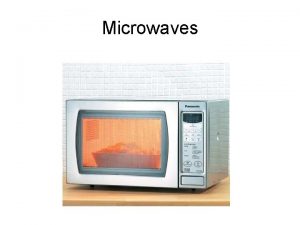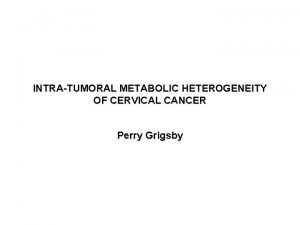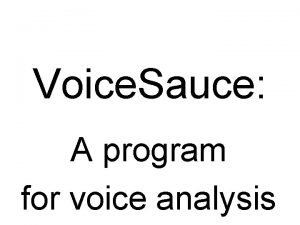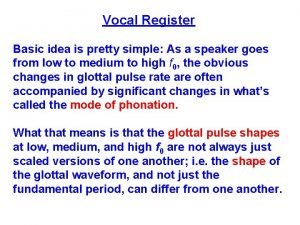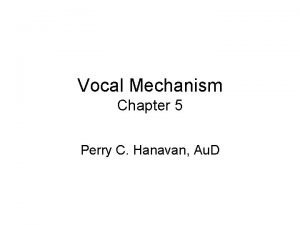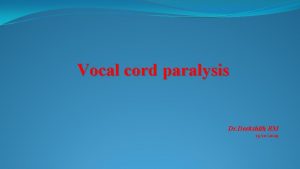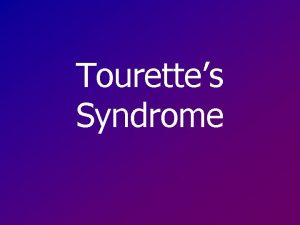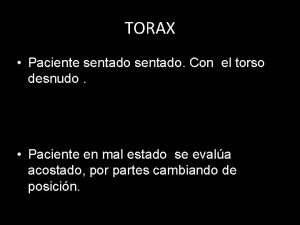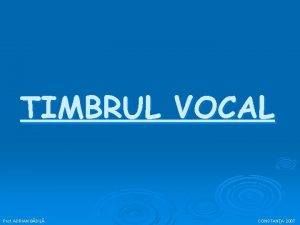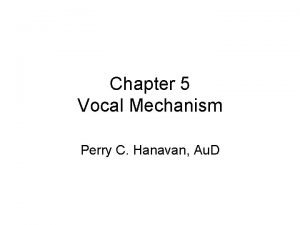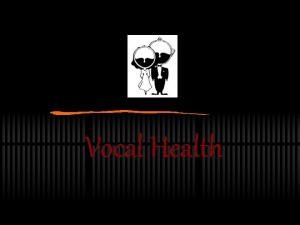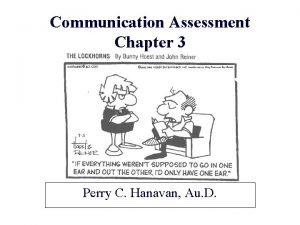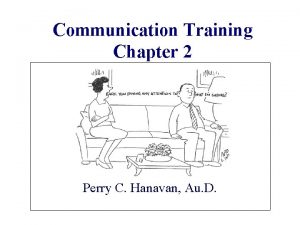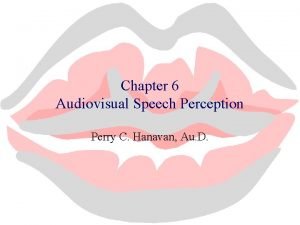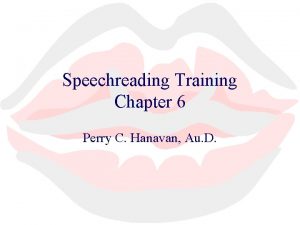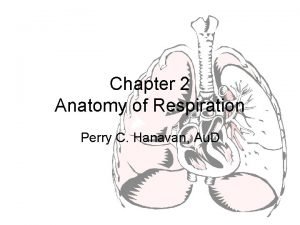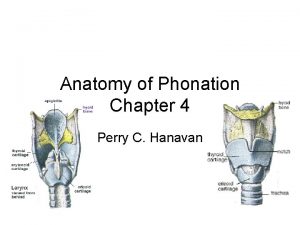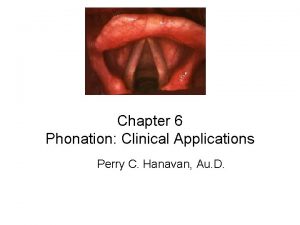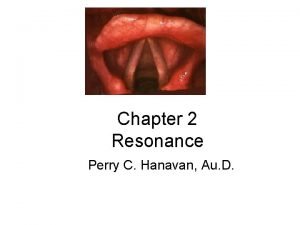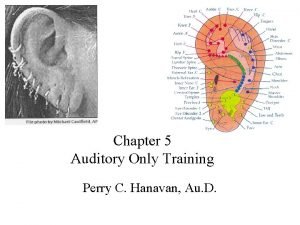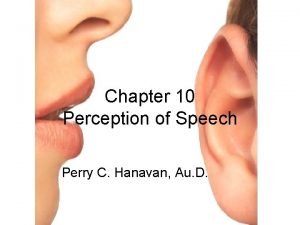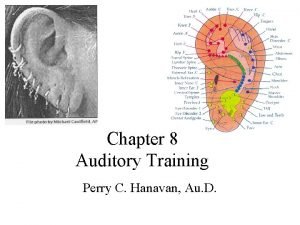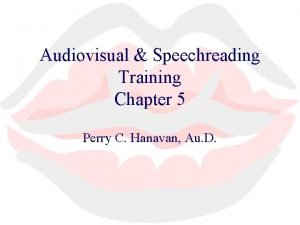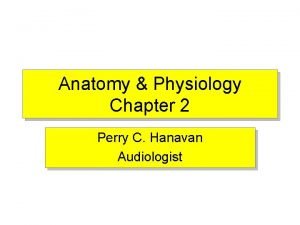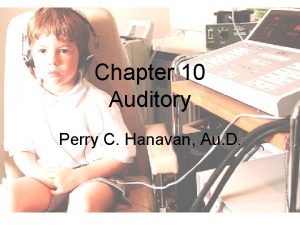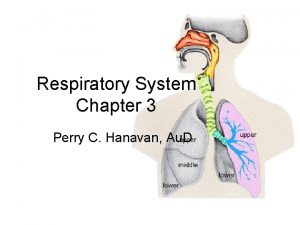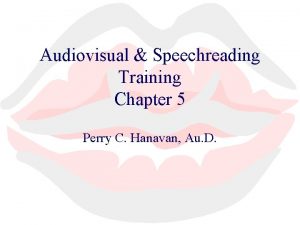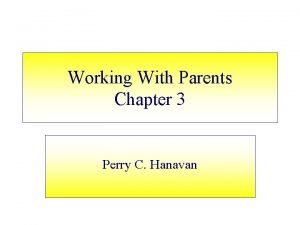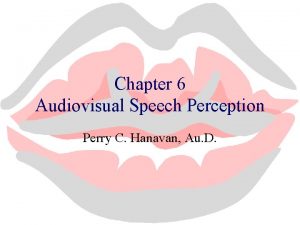Vocal Mechanism Chapter 5 Perry C Hanavan Au






















































- Slides: 54

Vocal Mechanism Chapter 5 Perry C. Hanavan, Au. D

Cultures The Jimi Hendrix of Mongolia Incredible Human Machine Steven Tyler Wall of Sound Naturally 7 Dr. Patricia Kuhl: Linguist Genius of Babies

Question The larynx is the: A. Voice box B. Throat C. Esophagus D. Nasal passage E. Oral cavity

Practice Labeling

Review

Swallowing Reflex • Bolus of food triggers reflex as it passes tongue above larynx • Larynx elevates • Epiglottis drops down to cover aditus (opening to larynx from pharynx) • Tight adduction of folds

Vocal Fold Functions

Laryngeal Function for Speech • Attack – Simultaneous – Breathy – Glottal • • Termination Sustained phonation Vocal register Whispering

Laryngeal Function for Speech • Attack - process of bringing folds together for phonation, requires muscles (three types): – Simultaneous - adduction and onset of exhalation occurs together – Breathy - airflow begins before phonation “hope”, Breathy phonation - failure to completely close folds – Glottal- used when word begins with stressed vowel, normal process (Hard glottal attack – damaging) • Termination - process of fold retraction (abduction) • Sustained phonation - requires maintenance of tonic (sustained tensing) of musculature (actual phonation does not require repeated adduction and abduction)

Phonatory System

Larynx

Question The only bone of the larynx is: A. Thyroid B. Cricoid C. Arytenoid(s) D. Epiglottis E. Hyoid

Larynx

Question The vocalis muscle attaches to: A. Thyroid B. Cricoid C. Arytenoid(s) D. B and C E. A and C

Question The largest cartilage is the: A. Thyroid B. Cricoid C. Arytenoid(s) D. Mandible E. Hyoid

Larynx

Question To close or bring together: A. Abduct B. Adduct C. Neither

Vocal Folds

Muscles of Larynx • Extrinsic – Have one point of attachment to larynx and other attachment other structure • Intrinsic – Have origin and insertion within larynx

Question The vocalis is an ____ laryngeal muscle: A. Extrinsic B. Intrinsic C. Both D. Neither

The Vocal Folds

Developmental

Vocal Length Change with Age

Myoelastic-Aerodynamic Theory • Model describing voice production (phonation) as a combination of: – Muscle force (myo) – Tissue elasticity (elasticity) – Pressures and flows (aerodynamic) • The Bernoulli Effect: the Physics Behind Your Voice - You. Tube

Mucosal Wave • Examples – Mucosal Wave – Asymmetrical Mucosal Wave – Spasmodic dysphonia

Mucosal Wave • Vertical phase difference • Longitudinal phase difference

Question The Bernoulli principle: A. B. C. D. E. F. As velocity increases, pressure decreases As velocity decreases, pressure increases As velocity increases, pressure increases As velocity decreases, pressure decreases A and B are true C and D are true

Bernoulli Principle • As flow increases, pressure decreases – Subglottal air pressure increases and forces vocal folds to abduct – Rapid flow of air through glottal space decreases pressure in the glottis and vocal folds close

Phonation: Glottal Spectrum • Determined by mass, length, and tension • Changes throughout utterance (question vs. statement, etc. ) • Males Fo (80 -150) • Females Fo (180 -250) • Children Fo (250 -300)

Glottal Spectrum • Glottal Fo with harmonics • Does not represent what is heard due to vocal tract modulation • The Fo corresponds to the perceived pitch of the voice • The harmonics contribute to the quality of the voice

Fo & Harmonic Spacing • Adult Male • Adult Female • Child

Roll Off--Fo

Question Who has the largest harmonic spaces (distance between harmonics)? A. Males B. Females C. Young girls D. Young boys E. C & D

Voice Quality • Cycle-to-cycle variations in frequency and amplitude can occur from several factors: – Neurologic – Biomechanic – Aerodynamic – Hearing loss (inadequate feedback system)

Voice Quality • Hyperadducted • Hypoadducted

Vocal Registers • Vocal register - differences in mode of vibration of vocal folds – Modal register - pattern of phonation used in daily conversations – Glottal fry - (rough voice) vibrating portion flaccid, lateral portion tensed resulting in strong medial compression with short, thick folds and low glottal pressure – Falsetto - long and extremely thin folds – Whistle register - turbulence on edge of vocal folds – Whispering - not actually phonatory because no voicing partially adducted and tensed to produce turbulence, strenuous and fatiguing

Vocal Registers

Glottal Fry • Also known as pulse register or Strohbass (straw bass) • Vocal folds vibrate between 30 and 90 Hz • Frying pan sound of eggs frying • Low subglottal pressure • Tension of the vocalis is significantly reduced relative to modal vibration, so that the vibrating margin is flaccid and thick. The lateral portion of folds is tensed creating thick folds • Example

Glottal Fry Vocal Fry

Falsetto • A singing technique that produces sounds that are pitched higher than the singer's normal range • Vocal folds lengthened and become extremely thin • expansion and separation of vocal cords, in which case, only the edges of the vocal cord vibrate, not the entire vocal cord • used by male countertenors to sing in the alto range, before women sang in choirs. • It is a very common technique in soul music, and has also been made popular in heavy metal • How to sing falsetto • Falsetto Voice Phrases

Whistle Register • Register above falsetto • (flageolet register) is the highest register of the human voice • Up to 2500 Hz in females • Product of turbulence on the edge of the vocal fold • Not considered a mode of vibration as product of turbulence • Mariah Carey

Whispering • Not a phonatory mode • Voicing removed • Mariah Carey

Whistle and Falsetto • Elton John perfoms Benny and The Jets on Soul Train (falsetto) • Mariah Carey's Whistle Register Collection

Vocal Fry • Vocal fry: Why talking like Kim Kardashian and Katy Perry is bad for your health • What Is Vocal Fry & Is It Bad For You?

Abnormal Voice • Dysphonia – generic term for any voice that sounds deviant in terms of quality, pitch, and/or loudness • Spasmodic Dysphonia - Muscle Tension Dysphonia - Optimal Breathing Voice Training • Spasmodic dysphonia • Hoarseness Explained Medical Course

Question Maintaining childhood pitch despite having passed through puberty… A. Aphonia B. Puberphonia C. Phonia fear D. Non-phonia

Puberphonia • Maintenance of the childhood pitch despite having passed through puberty • Puberphonia • Other voice disorders

Abnormal Voice • Breathy Voice • Hoarse/Rough Voice

FO & Hearing Loss • Leder SB, Spitzer JB, Kirchner JC. Ann Otol Rhinol Laryngol. 1987 May-Jun; 96(3 Pt 1): 322 -4. – Speaking fundamental frequency of postlingually profoundly deaf adult men. Investigated speaking fundamental frequency (F 0) of 21 postlingually profoundly sensorineurally deaf males • Speaking F 0 was significantly higher for the deaf group than for normal-hearing, age-matched men. • Neither duration of profound deafness nor hearing aid usage affected speaking F 0 values significantly.

Hearing vs. Hearing Loss J Acoust Soc Am. 1982 Jan; 71(1): 196 -202. Long-term average speech spectra for normal and hearing-impaired adolescents. Monsen RB. Spectra characterized by regular pattern of peaks occurring at multiples of the talkers' fundamental frequencies and by slopes declining at rates of -5 to -6 d. B/octave. Adolescents with HL produced spectra for which the harmonic structure ranged from very well defined to the irregular and poorly defined; spectral slopes declined at rates equal to or greater than the normal rate, in some cases declining at twice the normal rate.

Hearing vs. Cochlear Implant OBJECTIVE: The different speech sounds are formed by the primary voice signal and by the shape of the articulation tract. With this mechanism, specific overtones, the formants, are generated for each vowel. The objective of this study was to investigate the fundamental frequency (F 0) of the voice signal and the first three formants (F 1 -F 3) as a parameter of the articulation in prelingually deafened children at different timepoints after cochlear implantation (CI) compared with children with normal speech development. CONCLUSIONS: Prelingually deaf children who receive a CI before fourth birthday attain better acoustic control over speech, normalizing fundamental frequencies and improving their articulatory skills. Int J Pediatr Otorhinolaryngol. 2002 Nov 11; 66(2): 115 -23. Changes of voice and articulation in children with cochlear implants. Seifert E, Oswald M, Bruns U, Vischer M, Kompis M, Haeusler R.

Parameters of Vocalizations

Voice Disorders • jitter – cycle to cycle variability in frequency of vocal fold vibration also called frequency perturbation • shimmer – cycle to cycle variability in amplitude of vocal fold vibration also called amplitude perturbation

Question Which is jitter? A. cycle to cycle variability in frequency of true vocal fold vibration also called frequency perturbation B. cycle to cycle variability in amplitude of vocal fold vibration also called amplitude perturbation C. cycle to cycle variability in frequency of false vocal fold vibration also called frequency perturbation D. cycle to cycle variability in amplitude of false vocal fold vibration also called amplitude perturbation
 False and true vocal cords
False and true vocal cords This country is known for its unique vocals
This country is known for its unique vocals Kalani perry
Kalani perry Perry glasser
Perry glasser Words that rhyme with perry
Words that rhyme with perry Richard perry neurologist
Richard perry neurologist Katy perry figurative language
Katy perry figurative language Chapter 18 apush
Chapter 18 apush Reece map
Reece map William g perry
William g perry Who was perry
Who was perry Perry como sunrise, sunset
Perry como sunrise, sunset Imagery in the song roar
Imagery in the song roar Perry’s theory of intellectual and ethical development
Perry’s theory of intellectual and ethical development Lee burdette williams
Lee burdette williams Dr. perry sugar
Dr. perry sugar Perry grigsby
Perry grigsby Daimyo definition ap world history
Daimyo definition ap world history Katy perry firework figurative language
Katy perry firework figurative language Videogame lawyer
Videogame lawyer Ivan perry
Ivan perry Perry high school marching band
Perry high school marching band Dog spay perry county
Dog spay perry county Perry babb
Perry babb Matt thiessen and katy perry
Matt thiessen and katy perry Clarence perry
Clarence perry Dr perry liu
Dr perry liu Dr richard perry neurologist
Dr richard perry neurologist First word on the cross
First word on the cross Dr josephine perry swimming
Dr josephine perry swimming Gabby perry
Gabby perry Kuhn perry
Kuhn perry Creative commons license
Creative commons license Perry zinn rowthorn
Perry zinn rowthorn Jason perry md
Jason perry md Gabby perry harvard
Gabby perry harvard Balamory painter
Balamory painter Perry high school marching band
Perry high school marching band Perry aritua
Perry aritua Mark perry brunel
Mark perry brunel Ut tyler letter of appreciation
Ut tyler letter of appreciation Perry meridian middle school
Perry meridian middle school Vocal muscles
Vocal muscles Voice sauce
Voice sauce Vocal registers
Vocal registers Kim kardashian
Kim kardashian Position of vocal cords
Position of vocal cords Paramedian vocal cords
Paramedian vocal cords Permanently damaged vocal cords
Permanently damaged vocal cords Pressness
Pressness Vocal tic examples
Vocal tic examples Torax en tonel
Torax en tonel Timbrul vocal
Timbrul vocal Fremitus test
Fremitus test Vocal gifts of the holy spirit
Vocal gifts of the holy spirit















